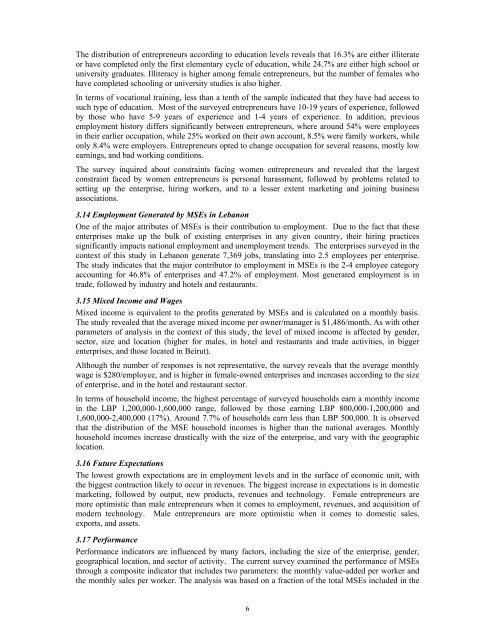MICRO AND SMALL ENTERPRISES IN LEBANON
MICRO AND SMALL ENTERPRISES IN LEBANON
MICRO AND SMALL ENTERPRISES IN LEBANON
You also want an ePaper? Increase the reach of your titles
YUMPU automatically turns print PDFs into web optimized ePapers that Google loves.
The distribution of entrepreneurs according to education levels reveals that 16.3% are either illiterateor have completed only the first elementary cycle of education, while 24.7% are either high school oruniversity graduates. Illiteracy is higher among female entrepreneurs, but the number of females whohave completed schooling or university studies is also higher.In terms of vocational training, less than a tenth of the sample indicated that they have had access tosuch type of education. Most of the surveyed entrepreneurs have 10-19 years of experience, followedby those who have 5-9 years of experience and 1-4 years of experience. In addition, previousemployment history differs significantly between entrepreneurs, where around 54% were employeesin their earlier occupation, while 25% worked on their own account, 8.5% were family workers, whileonly 8.4% were employers. Entrepreneurs opted to change occupation for several reasons, mostly lowearnings, and bad working conditions.The survey inquired about constraints facing women entrepreneurs and revealed that the largestconstraint faced by women entrepreneurs is personal harassment, followed by problems related tosetting up the enterprise, hiring workers, and to a lesser extent marketing and joining businessassociations.3.14 Employment Generated by MSEs in LebanonOne of the major attributes of MSEs is their contribution to employment. Due to the fact that theseenterprises make up the bulk of existing enterprises in any given country, their hiring practicessignificantly impacts national employment and unemployment trends. The enterprises surveyed in thecontext of this study in Lebanon generate 7,369 jobs, translating into 2.5 employees per enterprise.The study indicates that the major contributor to employment in MSEs is the 2-4 employee categoryaccounting for 46.8% of enterprises and 47.2% of employment. Most generated employment is intrade, followed by industry and hotels and restaurants.3.15 Mixed Income and WagesMixed income is equivalent to the profits generated by MSEs and is calculated on a monthly basis.The study revealed that the average mixed income per owner/manager is $1,486/month. As with otherparameters of analysis in the context of this study, the level of mixed income is affected by gender,sector, size and location (higher for males, in hotel and restaurants and trade activities, in biggerenterprises, and those located in Beirut).Although the number of responses is not representative, the survey reveals that the average monthlywage is $280/employee, and is higher in female-owned enterprises and increases according to the sizeof enterprise, and in the hotel and restaurant sector.In terms of household income, the highest percentage of surveyed households earn a monthly incomein the LBP 1,200,000-1,600,000 range, followed by those earning LBP 800,000-1,200,000 and1,600,000-2,400,000 (17%). Around 7.7% of households earn less than LBP 500,000. It is observedthat the distribution of the MSE household incomes is higher than the national averages. Monthlyhousehold incomes increase drastically with the size of the enterprise, and vary with the geographiclocation.3.16 Future ExpectationsThe lowest growth expectations are in employment levels and in the surface of economic unit, withthe biggest contraction likely to occur in revenues. The biggest increase in expectations is in domesticmarketing, followed by output, new products, revenues and technology. Female entrepreneurs aremore optimistic than male entrepreneurs when it comes to employment, revenues, and acquisition ofmodern technology. Male entrepreneurs are more optimistic when it comes to domestic sales,exports, and assets.3.17 PerformancePerformance indicators are influenced by many factors, including the size of the enterprise, gender,geographical location, and sector of activity. The current survey examined the performance of MSEsthrough a composite indicator that includes two parameters: the monthly value-added per worker andthe monthly sales per worker. The analysis was based on a fraction of the total MSEs included in the6
















